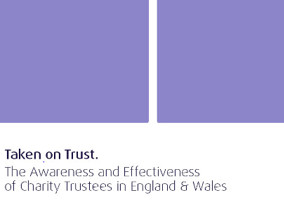One of the most revealing and interesting pieces of information in Taken on Trust, last year's Charity Commission report into trusteeship, is how divided the voluntary sector is. The report reminds us, in effect, that there isn't one charity sector.
Our sector is sometimes described as a loose and baggy monster - a group of bodies which have little common ground - only a legal structure and a set of principles.
I’m not sure that's quite right. Charities aren’t in the business of doing the same thing and they don’t have the same business model. So I don’t think there is one typical charity. But I think we can find a framework into which we fit those different organisations.
Perhaps the best analogy is that charities are like breeds of dog. Outwardly, they can look very different, but all share something which is essentially the same.
Who's in the tent?
First, perhaps it’s worth culling the bodies on the Charity Commission register which NCVO excludes from its definition of general charities - including independent schools, universities, housing associations, religious organisations, and state bodies - to leave what we might call the voluntary sector.
Voluntary sector bodies exist to make the world a better place. Broadly they do this in three ways. A smallish group of arts and heritage organisations preserve some aspect of our common culture. A larger group exist to ameliorate some form of systemic disadvantage - to make life fairer in some way. And by far the largest group of charities exist simply to bring communities of people together.
These groups aren’t the same, though. The "fairness” sector is significantly more professionalised. That is, paid staff are usually at least comparable in number to trustees, although they may be outnumbered by other volunteers. The bigger group of voluntary community bodies operates almost entirely without money. It is choirs, ramblers associations, guide troops and WIs.
The fact that most charities are community bodies, though, explains two things - why half of all trustees are beneficiaries, and why charities are more common in affluent areas. If the most common charity is a village hall or WI then of course trustees are beneficiaries, and of course there are more in affluent areas, where people have time for association and the skills to establish formal bodies.
If I were to try to capture the public image of a charity, I would say it is the "fairness sector" which they first think of when they hear the word.
This group of fairness charities is obviously then divided into the familiar silos of beneficiary group, which separates out some charities further - aid and animals in particular, because unlike most charities they do not support people facing disadvantage in the UK.
Where does the money come from?
Charities which raise money in the same way often have a lot in common.
An analysis by nfpSynergy last year found six main income streams - fundraising, legacies, trading, service delivery, investment and “linked charities” - a surprisingly common arrangement where a single stakeholder provides all the funds.
It also found that broadly, charities’ single largest income stream seems to largely define their behaviour.
Service delivery charities tend to have very different structures, and to be subject to the pressures of markets and external competitors. Lower levels of autonomy seem to make them more vulnerable to mission drift.
Those funded by investment are likely to have much smaller staff, and to have particular questions of accountability. They are also much less likely to deliver front line services themselves - for no particularly fundamental reason, when you think about it.
Those driven by fundraising and trading are the face of the sector, because they interact daily with supporters, and because brand awareness is a key tool they use to raise money. Again, when the public think of a typical charity, these are what they have in mind. Many people think they are the whole sector. And it is these charities' behaviour which really drives public trust.
Scale
Another way to divide charities up is by size.
Scale is obviously about resource, but I think it’s more helpful to think in terms of head count, because that is what drives how a charity is run.
The biggest divide is between voluntary and professional organisations. Taken on Trust found that 80 per cent of registered charities have no employees or volunteers other than the trustees. Almost all these charities had a turnover of less than £100,000 a year.
At the other end of the spectrum, we have a handful of really huge charities with significant income, and significant reputations - probably no more than a couple of hundred.
In the middle there are 30,000 or so charities where the paid staff do the work, but everyone knows each other personally. (This, again, is the public's typical charity.)
We need to take fundamentally different approach to these three groups of charities, because reputationally and relationally they can have little common ground. They inhabit different worlds, need different support, and have different needs.
To me it's about how the executive and board connect to the staff and the cause. If the organisation is voluntary the connection is visceral. The administrators are the users. If it's a small-to-medium charity the connection is personal. The senior individuals have a direct connection.
Scale obviously comes with significant advantages but one problem is that the personal connection is lost. When we talk about a lack of trust in charity, I suspect it is these 200 charities we are talking about.
Connected to scale is the issue of reach - whether a charity is local or national or regional, or sometimes a mixture. Charities delivering in local communities are focused on different networks. They have different approaches and different needs.
The sector’s focus on lobbying and fundraising makes it very centralised. Almost half of all professional charity workers are based in London, and more than half the money in the sector is accrued in London. Which makes it a real challenge to represent the 50 million Britons who live and work elsewhere.
What does it mean?
Hopefully this offers some clear bounds on a sector which seems sometimes to sprawl. Each charity should fit somewhere in this framework. If I wanted to get more granular, I could have written more about the geographical location in which you deliver, and the primary channels you use - lobbying on behalf of beneficiaries, providing information, using a physical location.
Each charity will have common bounds with many others in this framework but will most likely also find itself unique, or nearly so, when all the above factors are taken into account. It is this, perhaps, which means that those looking from the outside see a clear case for more mergers while these within often do not.
I think it also means our sector looks different from how it is often perceived. It means there are probably less than 4,000 charities which fit the public archetype. And it indicates to me that the legal definition and the practical expectation of what a charity is are very different. I wonder if it’s time the former was brought a little closer to the latter.










